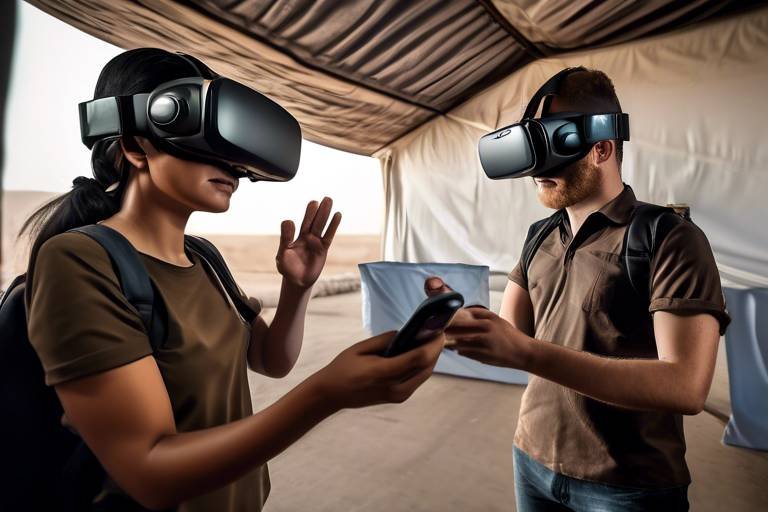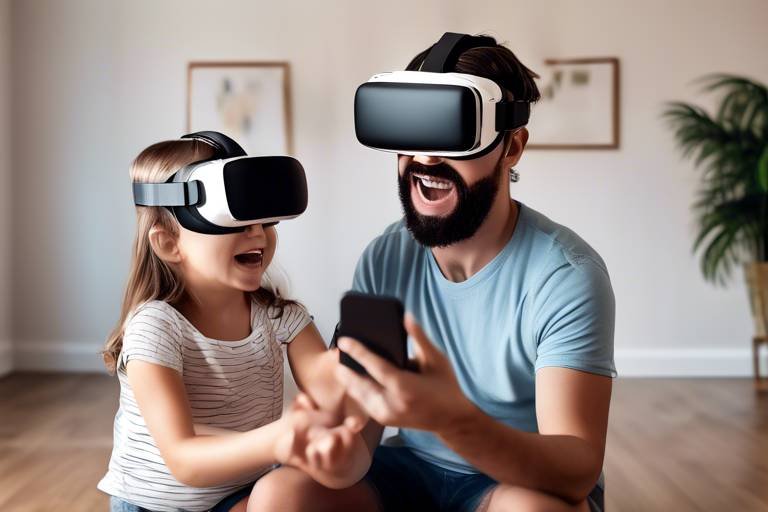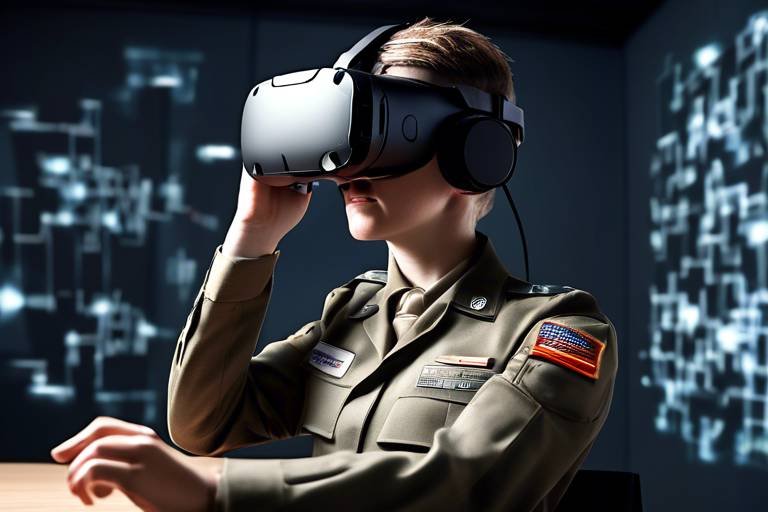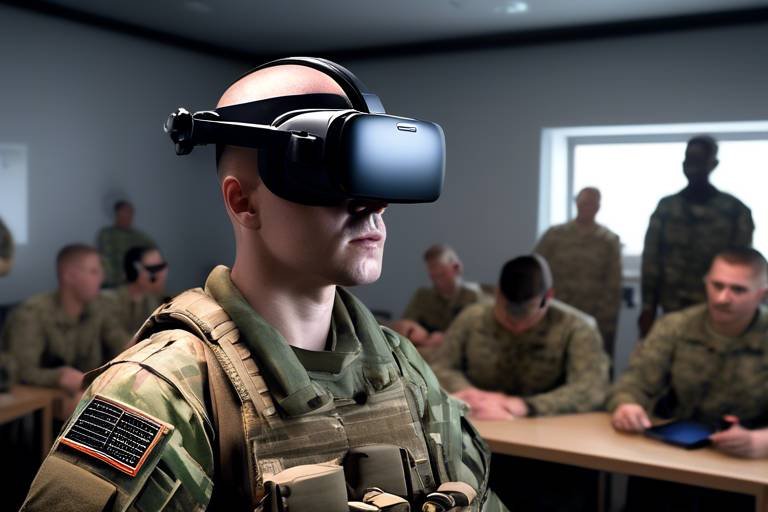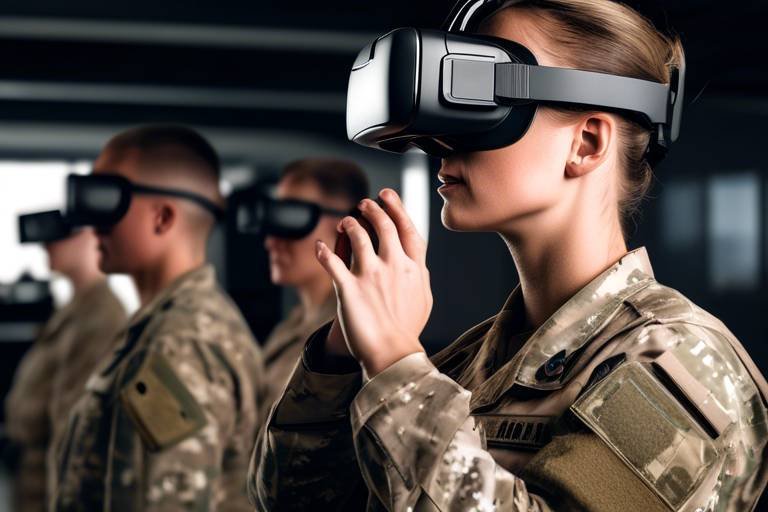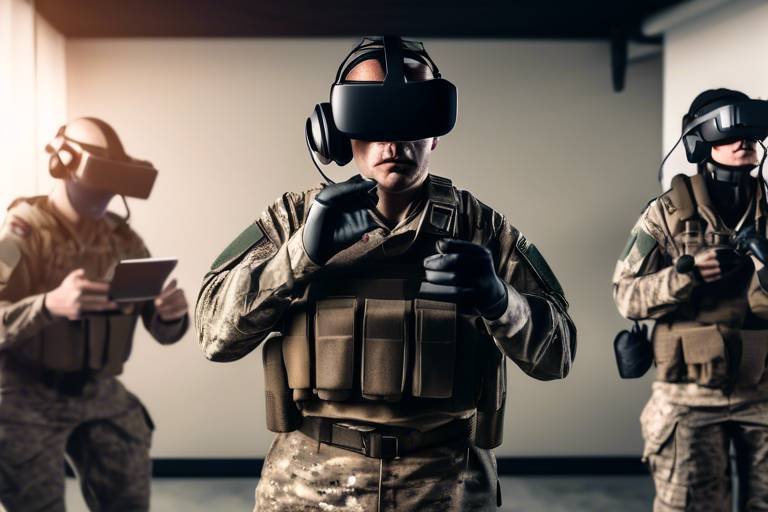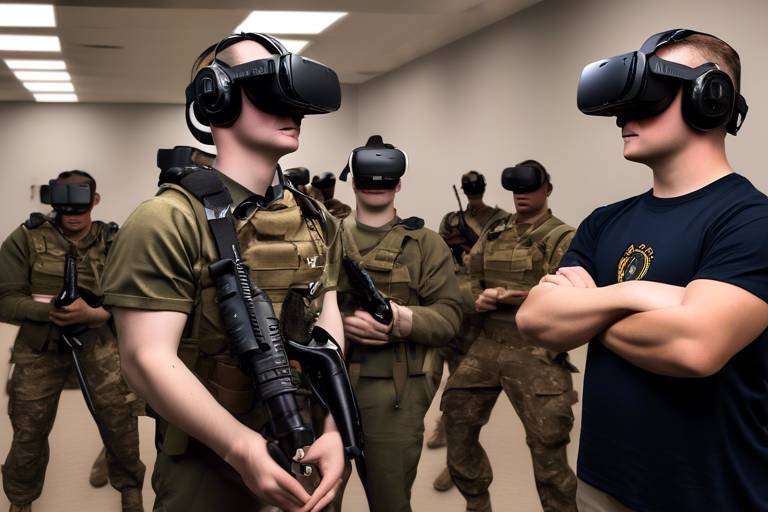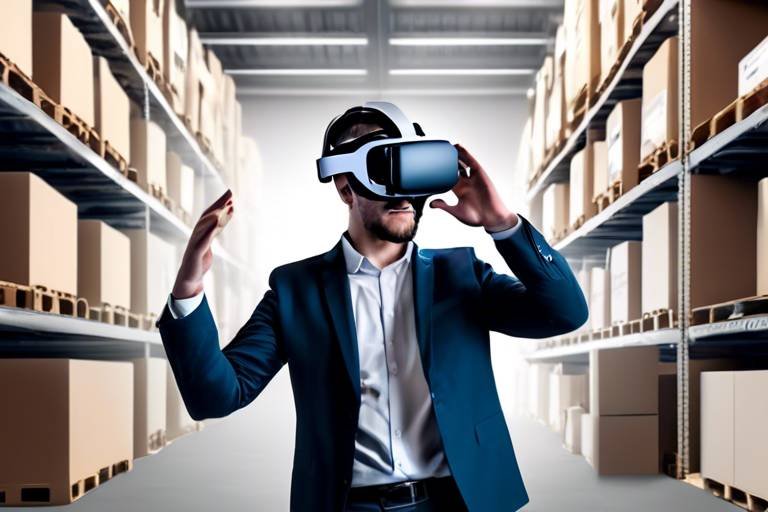The Impact of Virtual Reality on Training for Chemical Warfare
The emergence of Virtual Reality (VR) technology has revolutionized various sectors, and its impact on training for chemical warfare is particularly profound. As the stakes in military and emergency response scenarios continue to escalate, the need for effective training methods has never been more critical. Traditional training approaches, while foundational, often fall short in preparing personnel for the complexities and dangers of real-world chemical threats. Enter VR, a game-changer that offers immersive experiences designed to enhance preparedness and response. This article delves into how VR technology is not just a trend but a significant advancement that transforms the landscape of chemical warfare training.
Imagine a scenario where trainees can step into a fully immersive environment that replicates the chaos and urgency of a chemical attack. With VR, this is not just a distant dream; it’s a reality. The technology allows for the creation of scenarios that mimic the unpredictability of actual incidents, enabling trainees to practice their responses in a safe yet realistic setting. This capability is crucial, as it helps build muscle memory and cognitive skills needed in high-pressure situations. The ability to repeatedly engage with these scenarios ensures that when the time comes to act, individuals are not just reacting instinctively but are equipped with the knowledge and skills to make informed decisions.
Furthermore, VR's potential extends beyond mere simulation. It enhances the learning experience by integrating various sensory inputs, creating a multi-faceted training environment. Trainees can experience the sights, sounds, and even smells associated with chemical warfare, which significantly increases their engagement and retention of critical information. Unlike traditional methods that may involve passive learning through lectures or videos, VR promotes active participation, making the training process not only more effective but also more enjoyable.
However, while the advantages of VR in training for chemical warfare are substantial, it’s essential to recognize the challenges associated with its implementation. Organizations must navigate the complexities of technology acquisition, training personnel to use the systems effectively, and ensuring that the content remains relevant and updated. Despite these hurdles, the long-term benefits of enhanced preparedness and response capabilities make the investment worthwhile.
As we look to the future, the implications of VR in this field are exciting. With advancements in technology, we can expect even more sophisticated simulations that include real-time data analytics, allowing for personalized training experiences. This evolution not only promises to improve the effectiveness of training but also enhances safety for those on the front lines of chemical warfare response.
- What is Virtual Reality (VR) training?
VR training involves using immersive simulations to replicate real-world scenarios, allowing trainees to practice their responses in a controlled environment. - How does VR improve training for chemical warfare?
VR provides realistic simulations that enhance engagement, retention, and decision-making skills under pressure, preparing trainees for actual incidents. - What are the challenges of implementing VR training?
Challenges include the high cost of technology, technical limitations, and the need for ongoing content updates and personnel training. - What does the future hold for VR in military training?
The future looks promising, with advancements expected to make training even more effective and tailored to individual needs.

The Evolution of Training Methods
Training for chemical warfare has undergone a remarkable transformation over the years. In the early days, military personnel relied heavily on conventional methods such as lectures, textbooks, and basic simulations. These traditional approaches, while informative, often lacked the immersive experience needed to prepare individuals for the unpredictable nature of chemical warfare. Imagine trying to learn how to swim by reading a book! It’s simply not enough to grasp the complexities involved.
As the world faced increasing threats from chemical agents, the need for more effective training solutions became evident. The shift began with the introduction of basic simulation technologies that allowed trainees to experience scenarios in a controlled environment. However, these simulations were often limited in scope and realism. With the advent of advanced technology, we now stand on the brink of a new era in training methodologies.
The introduction of Virtual Reality (VR) has revolutionized the way we train for chemical warfare. VR technology enables trainees to engage in highly realistic scenarios that mimic real-world conditions. This evolution can be summarized in a few key phases:
- Phase 1: Traditional Training - Focused on theoretical knowledge and basic drills.
- Phase 2: Basic Simulations - Introduced controlled environments but lacked realism.
- Phase 3: Immersive VR Training - Created lifelike scenarios that enhance preparedness and response.
Today, VR training not only enhances the realism of scenarios but also allows for a more comprehensive understanding of the various factors that can impact a chemical warfare situation. For instance, trainees can experience different environmental conditions, such as extreme weather or challenging terrains, which are crucial for effective decision-making in the field.
Moreover, the ability to simulate hazardous situations without real-world risks is a game-changer. Trainees can practice their responses to chemical exposure in a safe environment, allowing them to build confidence and competence. This evolution in training methods signifies a profound shift in how we prepare our military and emergency responders for the challenges they may face in the field.
In conclusion, the evolution of training methods from traditional techniques to modern VR solutions reflects a growing understanding of the complexities involved in chemical warfare. The immersive nature of VR not only enhances the training experience but also equips personnel with the skills they need to respond effectively in real-world situations. As we look to the future, it is clear that this evolution will continue to shape the training landscape, ensuring that our forces are better prepared than ever before.

Benefits of Virtual Reality in Training
Virtual reality (VR) has revolutionized the way we approach training, especially in high-stakes environments like chemical warfare. Imagine stepping into a world where you can practice your responses to potential threats without the fear of real-world consequences. This is precisely what VR offers. The immersive nature of virtual reality not only captures the attention of trainees but also enhances their learning experiences in ways traditional methods simply cannot match.
One of the standout advantages of VR is its ability to provide realistic simulations. Trainees can engage in scenarios that mimic real-life situations they might face during a chemical attack. For instance, they can practice donning protective gear, navigating hazardous environments, and executing emergency protocols—all within a controlled setting. This level of realism is crucial because it prepares them for the unpredictability of actual events, making them more adept at decision-making under pressure.
When we talk about realistic simulations in VR training, we are referring to the creation of environments that closely resemble the conditions of a chemical warfare incident. For example, a trainee might find themselves in a virtual city where a chemical leak has occurred. They would have to assess the situation, identify the source of the leak, and execute appropriate safety measures. This kind of training fosters a deeper understanding of the complexities involved in such scenarios. With VR, the stakes feel real, even though the environment is entirely virtual.
Moreover, VR can replicate various environmental conditions that impact decision-making and response. From different weather patterns to challenging terrains, trainees can experience how these factors influence their actions during a chemical crisis. For instance, a scenario might involve navigating through a foggy area where visibility is low, or a situation where high winds are dispersing chemicals. These environmental factors are critical for honing the skills necessary to operate effectively in the field.
Another significant benefit of VR is its ability to simulate hazardous situations without putting trainees at risk. In traditional training, exposing individuals to actual chemicals is not only dangerous but also impractical. VR circumvents this issue, allowing trainees to practice their responses to chemical exposure in a safe environment. They can learn how to use detection equipment, administer first aid, and coordinate with emergency services—all while experiencing the urgency and pressure of a real-life scenario.
Engagement is a crucial element of effective learning, and VR excels in this area. The immersive experience captivates trainees, making them more likely to stay focused and absorb the information presented. Studies have shown that when individuals are actively engaged in their learning environment, their retention rates improve significantly. This means that not only are trainees learning the protocols and procedures, but they are also more likely to remember them when it matters most.
In conclusion, the benefits of virtual reality in training for chemical warfare are profound. From realistic simulations that prepare individuals for real-world challenges to enhanced engagement that boosts retention, VR is a game-changer. As technology continues to evolve, we can expect even more innovative applications of VR in training, ultimately leading to better-prepared military and emergency response teams.
- What is virtual reality training? Virtual reality training involves using immersive technology to simulate real-world scenarios for educational purposes.
- How does VR improve training outcomes? VR enhances realism, engagement, and retention, allowing trainees to practice skills in a safe yet realistic environment.
- Are there any risks associated with VR training? While VR is generally safe, technical issues such as motion sickness can occur for some users.
- What are the costs associated with implementing VR training? The initial investment in VR technology can be high, but the long-term benefits often justify the cost.

Realistic Simulations
Imagine stepping into a world where every detail is meticulously crafted to mirror reality. This is the magic of virtual reality (VR) training for chemical warfare. Unlike traditional training methods that often rely on theoretical knowledge or outdated simulations, VR immerses trainees in lifelike environments where they can experience the chaos and urgency of a chemical incident first-hand. This immersive experience is not just about flashy graphics; it’s about preparing individuals for the high-stakes moments they may face in real life.
One of the standout features of VR is its ability to create realistic scenarios that mimic actual chemical warfare situations. Trainees can find themselves in a variety of settings—whether it's a crowded urban area, a military base, or an industrial site—each with its unique challenges. For instance, they might have to navigate through a chemical spill in a bustling city while managing the panic of civilians. This level of realism is crucial because it allows trainees to practice their skills in a safe yet challenging environment, enhancing their confidence and competence.
Moreover, VR simulations can be tailored to include specific environmental factors that trainees might encounter in the field. Consider the impact of weather conditions: a sudden downpour can change the dynamics of a chemical response, affecting visibility and the behavior of hazardous materials. With VR, trainees can experience these scenarios, learning to adapt their strategies in real-time. This adaptability is essential, as real-world situations are rarely straightforward.
Furthermore, VR enables the simulation of hazardous situations without the associated risks. Trainees can practice their responses to various chemical exposure scenarios, such as dealing with toxic fumes or managing decontamination processes. This hands-on experience is invaluable as it allows individuals to make mistakes and learn from them without the fear of real-world consequences. They can experiment with different approaches, understand the implications of their decisions, and refine their skills in a controlled setting.
In summary, the use of realistic simulations in VR training for chemical warfare is a game-changer. By providing immersive, adaptable, and safe training environments, VR not only enhances learning but also better prepares individuals for the unpredictable nature of chemical incidents. The stakes are high, and with VR, we are taking significant strides toward ensuring that our responders are ready for anything.
- What is virtual reality training?
Virtual reality training involves using VR technology to create immersive environments for training purposes, allowing individuals to practice skills in realistic scenarios.
- How does VR improve training for chemical warfare?
VR improves training by providing realistic simulations, enhancing engagement, and allowing trainees to experience hazardous scenarios safely.
- Are there any risks associated with VR training?
While VR training is designed to be safe, there can be technical issues or discomfort for some users, such as motion sickness.
- What are the future prospects of VR in training?
The future of VR in training looks promising, with advancements in technology likely to enhance realism and effectiveness even further.

Environmental Factors
Virtual reality (VR) technology has the remarkable ability to replicate a myriad of environmental conditions that are crucial for effective training in chemical warfare. Imagine being able to train in a virtual environment that mimics the exact weather patterns, terrain, and atmospheric conditions you might encounter in a real-world scenario. This level of realism not only enhances the training experience but also prepares trainees for the unpredictability of actual situations. For instance, VR can simulate a hot, arid desert where visibility is low due to sandstorms, or a humid jungle filled with dense foliage that can obscure vision and complicate operations.
Moreover, these environmental factors can significantly influence decision-making and response strategies. When trainees are immersed in a VR scenario that accurately reflects the challenges posed by different environments, they learn to adapt their tactics accordingly. For example, they might need to consider how wind direction could affect the dispersal of a chemical agent, or how the terrain could hinder their mobility and access to safety. By training in such controlled yet realistic settings, participants develop a better understanding of the dynamics at play during a chemical incident.
Another critical aspect of environmental simulation is the ability to introduce dynamic changes throughout the training session. This means that trainees can experience shifts in weather conditions, such as sudden rain or temperature drops, which can affect their gear and operational effectiveness. These simulations help to cultivate a sense of urgency and adaptability, essential traits for anyone involved in emergency response. The more realistic the training environment, the more prepared the trainees will be when faced with actual chemical threats.
In conclusion, the incorporation of environmental factors in VR training not only enriches the learning experience but also equips trainees with the skills they need to handle real-world challenges effectively. By immersing them in various simulated environments, VR ensures that they are not just learning theory but are also gaining practical insights into how to respond to chemical warfare scenarios.
- What is virtual reality training for chemical warfare?
Virtual reality training for chemical warfare involves using VR technology to create immersive simulations that prepare individuals for responding to chemical threats. - How does VR improve training effectiveness?
VR enhances training effectiveness by providing realistic scenarios, improving engagement, and promoting better retention of skills and knowledge. - What are the challenges of implementing VR training?
Challenges include the cost of technology, technical limitations, and the need for proper infrastructure to support VR training. - What future advancements can we expect in VR training?
Future advancements may include improved graphics, more sophisticated simulations, and greater accessibility of VR technology for training purposes.

Hazardous Situations
In the realm of chemical warfare training, the ability to simulate is not just an advantage; it is a necessity. Imagine being in a scenario where a chemical agent is released, and you have mere moments to react. The stakes are incredibly high, and the consequences of a wrong decision can be catastrophic. This is where virtual reality (VR) steps in, transforming the way we prepare for such critical moments.
With VR, trainees can immerse themselves in environments that replicate the chaos and unpredictability of a real chemical attack without any of the real-world risks. Picture this: a trainee dons a VR headset and suddenly finds themselves in a bustling urban area. Alarms blare, people are panicking, and a noxious cloud is swiftly approaching. In this controlled setting, they can practice their responses, learn to identify the signs of chemical exposure, and develop the muscle memory needed to act decisively. This type of training prepares them not just to think but to feel the pressure of the moment, which is crucial for effective decision-making.
Moreover, VR can recreate various types of hazardous situations, from chemical spills to airborne threats. Here are some examples of scenarios that can be simulated:
- Chemical Exposure: Trainees can learn how to recognize symptoms of exposure and the appropriate first aid measures.
- Evacuation Procedures: Simulations can include crowded areas where trainees must guide civilians to safety amidst chaos.
- Decontamination Protocols: Practicing the correct steps to decontaminate affected individuals or areas can be done without any real danger.
This immersive training not only enhances the skills of military personnel but also benefits emergency responders. Firefighters, paramedics, and police officers can all face scenarios involving chemical agents. By using VR, they can practice their roles in a safe environment, ensuring that when the real situation arises, they are ready to spring into action with confidence and precision.
Ultimately, the ability to experience hazardous situations through VR training is a game changer. It allows for repeated practice in a safe setting, enabling trainees to develop a deep understanding of both the physical and psychological challenges they may face in real life. As they navigate through these simulations, they gain invaluable insights that can mean the difference between success and failure in a crisis.
- What is VR training for chemical warfare? VR training for chemical warfare involves using virtual reality technology to create realistic scenarios that prepare military and emergency responders for chemical incidents.
- How does VR improve response to hazardous situations? VR enhances response by allowing trainees to practice in immersive environments, helping them develop critical skills and decision-making abilities under pressure.
- Are there risks associated with VR training? While VR training eliminates real-world risks, it is important to ensure that the technology is functioning correctly to avoid any potential issues during training sessions.
- What are the costs associated with implementing VR training? The costs can vary significantly based on the technology used, but many organizations find that the investment pays off in improved readiness and safety.

Enhanced Engagement and Retention
The realm of training is constantly evolving, and one of the most exciting advancements in recent years is the integration of virtual reality (VR). When it comes to training for chemical warfare, VR doesn't just enhance the experience; it transforms it. Imagine stepping into a fully immersive world where you can interact with your surroundings just like you would in real life. This level of engagement is a game changer, making learning not just effective but also exciting.
Why is engagement so crucial in training? Well, think about it: when you're fully immersed in a scenario, you’re more likely to remember what you learn. Traditional training methods often fall flat because they can be monotonous and uninspiring. With VR, however, the stakes feel real. Trainees can find themselves in a simulated chemical spill or a hazardous environment, making split-second decisions that could mean the difference between life and death. This kind of realistic practice is invaluable, as it leads to better retention of critical information and skills.
Research has shown that immersive learning environments significantly boost retention rates. In fact, studies indicate that learners retain up to 75% of the information presented in a VR setting compared to only 10% in traditional lectures. This is because VR engages multiple senses, creating a multidimensional learning experience. The combination of visual, auditory, and kinesthetic learning styles caters to different types of learners, enhancing the overall training effectiveness.
Moreover, the impact of VR on emotional engagement cannot be overlooked. When trainees experience fear, urgency, or the thrill of successfully navigating a dangerous situation, their emotional responses can create powerful memories. These memories are often easier to recall during real-life emergencies, as they are tied to strong emotional experiences. The brain tends to prioritize these emotional memories, which can lead to quicker, more effective responses in high-pressure situations.
In addition to improving retention, VR also fosters collaboration and teamwork. Many VR training programs allow multiple users to participate in the same simulation, encouraging communication and strategy development. This collaborative aspect not only enhances engagement but also mirrors real-life scenarios where teamwork is essential. Trainees learn to rely on one another, developing trust and camaraderie that are vital in emergency response situations.
In conclusion, the enhanced engagement and retention that virtual reality provides are crucial for effective training in chemical warfare. By immersing trainees in lifelike scenarios, VR not only makes learning more enjoyable but also ensures that the knowledge gained is retained long after the training session ends. As we continue to explore the possibilities of VR, it's clear that the future of training is not just about teaching; it's about transforming the way we learn and prepare for the challenges ahead.
- What are the primary benefits of using VR for chemical warfare training?
VR provides realistic simulations, enhances engagement, and improves retention rates, making it an effective training tool.
- How does VR improve decision-making skills?
By immersing users in high-pressure scenarios, VR helps trainees practice making quick decisions in a safe environment.
- Are there any drawbacks to implementing VR in training?
Yes, challenges include costs, technical limitations, and the need for proper training on how to use the technology effectively.
- What is the future of VR in training?
The future looks promising with advancements in technology that could further enhance the effectiveness and safety of training programs.

Challenges in Implementing VR Training
While the benefits of Virtual Reality (VR) in training for chemical warfare are substantial, it’s important to acknowledge the challenges that come with its implementation. Organizations looking to adopt this cutting-edge technology face several hurdles that can complicate the training process. From financial constraints to technical limitations, these challenges can impact the effectiveness of VR training programs.
One of the most significant barriers is the cost of technology. The initial investment required to acquire VR hardware and software can be daunting. For military and emergency response organizations, budgeting for such advanced technology might not always be feasible. Many organizations must consider whether the potential benefits justify the financial outlay. A
| Item | Estimated Cost |
|---|---|
| VR Headsets | $300 - $1,000 each |
| Software Development | $10,000 - $100,000 |
| Maintenance and Updates | $5,000 annually |
In addition to the costs, technical limitations present another hurdle. VR technology is not without its flaws; software glitches and hardware limitations can disrupt training sessions and frustrate trainees. Imagine preparing for a high-stakes situation only to be derailed by a malfunctioning headset! Such issues can lead to a lack of confidence in the training process and diminish the overall experience.
Moreover, the logistical challenges cannot be overlooked. Setting up VR training environments requires specific spaces that may not be readily available in all facilities. Organizations must also ensure that staff are adequately trained to operate the technology and troubleshoot issues as they arise. This added layer of complexity can slow down the adoption process and lead to inconsistencies in training delivery.
Lastly, there’s the need for content development. Creating realistic and effective training scenarios requires time and expertise. Organizations must invest in skilled personnel who can develop high-quality VR content that accurately simulates chemical warfare situations. This process can be resource-intensive, posing yet another challenge for those looking to implement VR training.
In summary, while the prospects of VR in training for chemical warfare are exciting, organizations must navigate a landscape filled with financial, technical, and logistical challenges. Addressing these issues will be crucial for the successful integration of VR technology into training programs.
- What are the main benefits of using VR for training? VR provides realistic simulations, enhances engagement, and improves retention of skills and knowledge.
- How much does VR training technology cost? The costs can vary widely, with initial investments ranging from hundreds to thousands of dollars depending on the equipment and software needed.
- What technical issues are commonly faced in VR training? Some common issues include software glitches, hardware limitations, and the need for specific training spaces.
- Is VR training safe? Yes, VR training allows for the simulation of hazardous situations without the real-world risks associated with chemical exposure.

Cost of Technology
When it comes to implementing virtual reality (VR) technology in training for chemical warfare, one of the most significant hurdles organizations face is the . The initial investment can be daunting, especially for military and emergency response organizations that operate on tight budgets. The expenses associated with VR training can be broken down into several key components:
- Hardware Costs: This includes the purchase of VR headsets, motion tracking systems, and high-performance computers capable of running sophisticated simulations. High-quality VR headsets can range from a few hundred to several thousand dollars each, depending on the features and capabilities.
- Software Development: Creating custom training scenarios tailored to specific needs can be expensive. Organizations may need to hire developers or purchase licenses for advanced simulation software, which can add significantly to the overall cost.
- Maintenance and Upgrades: Like any technology, VR systems require ongoing maintenance and periodic upgrades to ensure optimal performance. This can lead to additional costs over time.
Despite these initial financial implications, many organizations are starting to recognize the potential return on investment (ROI) that VR training can provide. By investing in VR technology, organizations can:
- Reduce Training Time: Trainees can quickly learn and master skills in a controlled environment, leading to faster preparedness.
- Enhance Safety: VR allows for practice in hazardous scenarios without the risk of real-world consequences, which can save costs associated with accidents or injuries.
- Improve Effectiveness: With realistic simulations, trainees are better prepared for actual situations, potentially reducing the costs associated with ineffective training.
Moreover, as VR technology continues to evolve, prices are expected to decrease, making it more accessible for organizations of all sizes. The shift towards more affordable solutions, such as cloud-based VR training platforms, could further alleviate financial concerns. In essence, while the upfront costs of VR training for chemical warfare may seem high, the long-term benefits and advancements in technology could make it a worthwhile investment.
- What is the average cost of VR training equipment? The average cost can vary widely but expect to invest several thousand dollars for a complete setup, including headsets and computers.
- Are there any ongoing costs associated with VR training? Yes, ongoing costs can include software updates, maintenance, and potential hardware upgrades.
- How does VR training improve preparedness for chemical warfare? VR training provides realistic simulations, allowing trainees to practice responses to chemical exposure in a safe environment.

Technical Limitations
While the potential of Virtual Reality (VR) in training for chemical warfare is undeniably exciting, it is essential to recognize the that can hinder its effectiveness. Imagine gearing up for a high-stakes mission, only to find that your training equipment is glitching or your simulation is lagging. These issues can create a frustrating experience for trainees and may even compromise their preparedness for real-world scenarios.
One of the primary challenges is the cost of technology. High-quality VR systems, which include advanced headsets, motion sensors, and powerful computers, come with a hefty price tag. Many military and emergency response organizations may struggle to allocate the necessary budget for such investments. This financial burden can limit the number of personnel who can be trained using VR, ultimately affecting the overall readiness of teams.
Moreover, technical issues such as software glitches, hardware malfunctions, and compatibility problems can arise, leading to interruptions during training sessions. For instance, if a trainee is in the middle of a critical simulation and the system crashes, it can disrupt their learning experience, causing frustration and a potential loss of valuable training time. These interruptions not only detract from immersion but also hinder the retention of skills and knowledge that are crucial in high-pressure situations.
Another aspect to consider is the learning curve associated with VR technology. Not all trainees may be comfortable or familiar with using VR systems, which can result in a lack of engagement. Some individuals might find it challenging to adapt to the virtual environment, leading to feelings of disconnection or anxiety. This can be particularly problematic in a training scenario where confidence and quick decision-making are paramount.
Lastly, we must also address the physical limitations of VR technology. Extended use of VR headsets can lead to discomfort or fatigue, which may distract trainees from focusing on the training objectives. Factors such as motion sickness, eye strain, or even physical discomfort from the headset can detract from the overall training experience. It's crucial for organizations to balance the benefits of immersive training with the physical well-being of their personnel.
In conclusion, while VR offers groundbreaking opportunities for training in chemical warfare, organizations must navigate these technical limitations to ensure successful implementation. By addressing the financial, technical, and physical challenges, military and emergency response teams can harness the full potential of VR technology and enhance their readiness for real-world scenarios.
- What are the main benefits of using VR for chemical warfare training?
VR provides realistic simulations, enhances engagement, and improves skill retention, making it a powerful tool for training. - What are the costs associated with implementing VR training?
The costs can vary significantly based on the technology used, but initial investments can be substantial, including hardware and software expenses. - How can organizations overcome technical limitations in VR training?
Investing in reliable technology, providing adequate training for users, and ensuring regular maintenance can help mitigate technical issues. - Can VR training replace traditional training methods?
While VR offers unique advantages, it is best used as a complement to traditional methods, providing a well-rounded training experience.

Future Implications of VR in Training
The future of virtual reality (VR) in training for chemical warfare is not just bright; it’s practically dazzling! As technology continues to advance at a breakneck pace, we can expect VR to evolve in ways we can only begin to imagine. One of the most exciting implications is the potential for hyper-realistic training environments. Imagine a scenario where trainees can experience a fully immersive battlefield, complete with realistic sounds, sights, and even smells. This level of immersion could revolutionize how military personnel and emergency responders prepare for real-life chemical warfare situations.
Moreover, as VR technology becomes more accessible and affordable, we will likely see a broader adoption of these training methods across various sectors, not just in the military but also in emergency response teams, healthcare, and even industrial safety training. This democratization of VR training could lead to a more prepared workforce, capable of responding effectively to chemical threats.
Another implication of future VR advancements is the integration of artificial intelligence (AI) into training simulations. Imagine a training scenario where the AI can adapt in real-time to a trainee’s decisions, providing personalized feedback and adjusting the difficulty level on the fly. This would not only enhance the learning experience but also ensure that each trainee is challenged according to their skill level, making training more effective and engaging.
Furthermore, the potential for remote training cannot be overlooked. With the rise of virtual reality platforms, trainees could participate in scenarios from anywhere in the world. This aspect is particularly crucial for organizations that may not have the resources to conduct large-scale in-person training exercises. Remote VR training could facilitate collaboration among international teams, allowing them to share knowledge and strategies for dealing with chemical warfare threats.
As we look to the future, it's also essential to consider the ethical implications of using VR for training. While the benefits are substantial, there must be a balance between realism and psychological safety. Developers will need to ensure that training scenarios do not inadvertently cause trauma or desensitize trainees to the real dangers of chemical warfare.
In conclusion, the future of VR in training for chemical warfare is filled with possibilities that could significantly enhance preparedness and response capabilities. As we continue to innovate and integrate new technologies, the training landscape will undoubtedly transform, creating a more effective and responsive workforce ready to tackle the challenges of chemical warfare head-on.
- What is the primary benefit of using VR for training in chemical warfare? VR provides realistic simulations that prepare trainees for real-world situations without the associated risks.
- How does VR training enhance engagement and retention? The immersive nature of VR captures attention and allows for experiential learning, which is proven to improve retention of skills and knowledge.
- What are some challenges associated with implementing VR training? Challenges include the high initial costs of technology, technical limitations, and the need for ongoing maintenance and updates.
- What does the future hold for VR training? Advancements in technology, AI integration, and remote training capabilities are expected to enhance the effectiveness and accessibility of VR training.
Frequently Asked Questions
- What is virtual reality (VR) training for chemical warfare?
Virtual reality training for chemical warfare involves using immersive VR technology to simulate real-life scenarios related to chemical threats. This training helps military and emergency responders practice their responses in a safe and controlled environment, enhancing their preparedness for actual situations.
- How does VR improve retention of skills and knowledge?
VR enhances retention by providing an engaging and interactive learning experience. Trainees are more likely to remember information and skills learned in an immersive setting compared to traditional methods. The realistic scenarios allow them to practice decision-making under pressure, which can lead to better recall during real-world situations.
- What are the main benefits of using VR in chemical warfare training?
The main benefits of VR in chemical warfare training include:
- Realistic simulations that prepare trainees for actual emergencies.
- The ability to replicate various environmental conditions, enhancing the training experience.
- Safe practice of hazardous situations without real-world risks.
- Increased engagement and improved knowledge retention.
- What challenges are associated with implementing VR training?
Implementing VR training can pose several challenges, including:
- High initial costs for VR technology and software.
- Technical limitations, such as hardware issues and software glitches.
- Logistical hurdles, including the need for adequate training space and support staff.
- How does VR prepare trainees for hazardous situations?
VR allows trainees to experience and respond to hazardous situations in a controlled environment. They can practice their reactions to chemical exposure, learn to use protective equipment, and develop strategies for safe evacuation without the risks associated with real-life scenarios.
- What does the future hold for VR training in chemical warfare?
The future of VR training in chemical warfare looks promising, with advancements in technology likely to enhance the effectiveness and safety of training programs. Innovations may include more realistic simulations, improved user interfaces, and greater accessibility, making VR an even more valuable tool for military and emergency response training.


